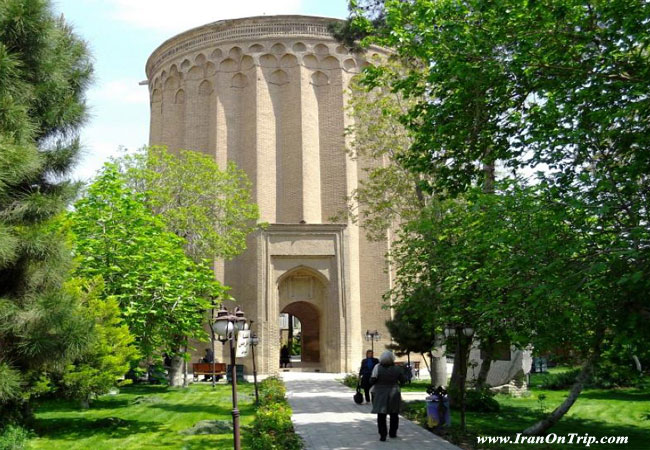Tugrul Tower

The Iranian towers that flourished in the Saljuq era (1037-1194) are glorious symbols of medieval time. This article attempts to explore the functions of the Iranian towers in medieval time with respect to Tugrul towers in Ray and Mehmandust. Regardless of their usage in astronomy and finding directions, towers functioned as symbols of dynasties.The Saljuqs who drew on earlier dynasties like the Buyids (932-1055) and Ziyarids (931-1090), followed their architectural traditions including constructing towers with remarkable innovations. Tugrul towers in Ray and Mehmandust of Damghan are two examples of Saljuq monuments. Tugrul Beg (990–1063) established the Seljuk Sultanate after conquering Iran and retaking the Abbasid capital of Baghdad from the Buyid dynasty in 1055. He died in Ray.
The tall brick Tugrul Tower is located near Ibn Babawayh monument in Ray. All the houses and gardens once surrounding the tower (Mohit Tabatabai, 1987, p.28) are now replaced by inharmonious houses, a giant factory and a newly constructed mosque next to it.
Tugrul tower with 11 meters inner diameter and 16 meters outer diameter is located in a beautiful garden. The entrance door of the garden is decorated elegantly. Without its dome collapsed in an earthquake (Mohit Tabatabaie, 1987, p.28) it is 20 meters high. The thickness of its walls varies from 1.75 to 2.75 meters.There had been a Kufic inscription at the top of the tower (Gardeshgar, 2008, p.39) which has now disappeared. On his way to Mashhad, Naser al-Din Shah ordered some restorations to be made to the top part of the tower, which was collapsing in 1884 (Mohit Tabatabai, 1987, 28). The tower now protected by Iran's Cultural Heritage Organization was restored slightly in 1998. On the marble plaque made by the Qajar dynasty, this building has been introduced as Boq’aya Tugrul.
The anonymous architect of the tower has done concrete measures to increase its durability. Tower resists moisture by air passing through the channels at the bottom of walls.The walls and ceiling were designed to reflect voices of lecturers or perhaps the sound of music. The exterior shape of the tower is that of a polygon with 24 angles which is thought to contribute to the structure's stability against tremors. The structure of the tower is like a solar watch to determine the exact time via its 24 angles
The holes in the inner walls which were once used to establish the upper parts of walls and its conical dome are now settled by pigeon and some other birds. The entrance of the tower with decorative bricks is like the mouths of angry snarling lion protecting its territories.
The brick tall Tugrul tower in Mehmandust was constructed in 1097. The exterior shape of the tower is that of a polygon with 12 angles. The tower’s conical dome and some part of its Kufic inscription have been destroyed
The position of towers and their height assist travelers to finds roads leading to cities. Moreover, the towers are used as the tombs and monuments of famous characters. Regarding Tugrul towers of Ray and Mehmandust there are many disputes among researchers. Tower of Ray considered to be founded by Tugrul I as his tomb (Abdul Jalil Razi, 2012, p. 476; Sumer, 2001, p.158), is claimed to be the tomb of Ebrahim Khawas (d.904) (Ibn Jawzi, 1996, 4, p.102), the great man in mysticism of 8th century (Shams al-Ulama & et.al,1879, 6, p. 369; Mohit Tababaie, 1987:28). It also was considered as the monument of Khalil Sultan, Timur (1370-1405)’s son and his wife Shad al-Mulk (Mohit Tabatabaie, 1987, p. 28).
The tower of Mehmandust known as Tugrul tower is considered as shrine of Qasim, the son of Musa Ibn Jafar (the 7th Shiite Imam) (Nejati, 1968, p. 142 )
It is apparent that the Iranian medieval towers had various functions with respect to their structures. Acting as tombs is the most common usage they possessed particularly in the conditions that new tombs were constructed in towers in different eras. Their shapes made them applicable for astronomical affairs. Moreover, they assist travelers to find their ways to cities.Besides, the towers functioned as symbols of political and architectural structures of the Iranian medieval dynasties. Towers flowered in the Ziyarid (932-1055), the Buyid (931-1090) and particularly the Saljuq (1037-1194) rules were as true symbols of these powers. Rulers of these dynasties and the architects serving them established these magnificent towers to perpetuate their names and their political and architectural structures.
.....
.....
.....

.jpg)



























